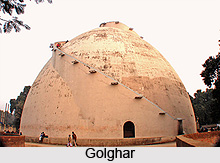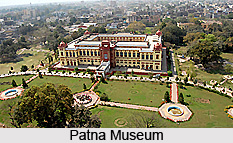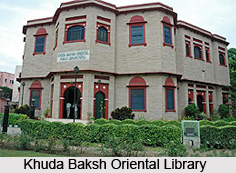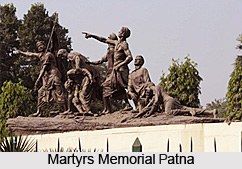 Patna , the imperial city of Bihar was once called Pataliputra. The capital of Bihar ,Patna , is among the world`s oldest capital cities with unbroken history of many centuries as imperial metropolis. A very fertile arched stretch of land along the bank of the Ganga. The history and heritage of modern day Patna go back well over two millennia. Like Delhi, Patna too had been the regal seat of governance for successive kingdoms since ancient times. And to this day, it is the capital city of the state. As each ruler ascended in power and established dynastic glory, he gave his capital a new name.
Patna , the imperial city of Bihar was once called Pataliputra. The capital of Bihar ,Patna , is among the world`s oldest capital cities with unbroken history of many centuries as imperial metropolis. A very fertile arched stretch of land along the bank of the Ganga. The history and heritage of modern day Patna go back well over two millennia. Like Delhi, Patna too had been the regal seat of governance for successive kingdoms since ancient times. And to this day, it is the capital city of the state. As each ruler ascended in power and established dynastic glory, he gave his capital a new name.
Thus, the ancient Kusumpura metamorphosed through Pushpapura, Pataliputra, Azeemabad and now into Patna , a continuous history ranging from 6th century BC to present times - a record claimed by few cities in the world. It was Ajatshatru the Magadha king who first built a small fort in Pataligram on the bank of the Ganga in 6th century BC, which later blossomed into the ancient glory still to be seen in the neighboring archaeological sites at Kumrahar. Bhiknapahari, Agamkuan, Bulandi Bagh and Kankar Bagh. Pataliputra dominated the political fortunes of the whole of north India between 6th century BC and 5th century AD, a fact established by archaeological excavations. After a temporary eclipse, in 16th century, Sher Shah Suri returned the city to its former glory and established the present Patna . After the decline of the Mughals, the British too found Patna a convenient regional capital and built a modern extension to this ancient city and called it Bankipore. It was in Gandhi Maidan in this area, that Mahatma Gandhi held his prayer meetings.
Golghar
Alarmed by the famine of 1770, captain John Garstin built this huge granary for the British army in 1786. The massive structure is 29 m high and the walls are 3.6 m wide at the base. The winding stairway around this monument offers a brilliant panoramic view of the city and the Ganga flowing by.
Martyr`s Memorial
A memorial to seven freedom fighters who sacrificed their lives in the Quit India Movement of August 1942, the Martyr`s Memorial is a modern sculpture facing the Secretariat, where they were shot in their attempt to host the national flag.
 Har Mandir Takht
Har Mandir Takht
Guru Gobind Singh, the tenth Guru of the Sikhs, was born in 1660 in Patna . The Har Mandir Takht, one of the four sacred shrines of the Sikhs, stands at this holy site. The original temple was built by Maharaja Ranjit Singh, and contains belongings of the Guru and Sikh holy texts.
Patna Museum
The Patna Museum houses a First World War cannon, metal and stone sculptures of the Mauryan and Gupta periods, Buddhist sculptures and quaint terracotta figures. A 16 m long fossilised tree is one of its special features.
Pathar ki Masjid
Adjacentto Har Mandir Sahib, on the bank of the Ganga, is this beautiful mosque built by Parwez Shah, son of Jehangir, when he was the governor of Bihar . It is also called Saif Khan`s mosque, Chimmi Ghat mosque and Sangi Masjid.
Khuda Baksh Oriental Library
Founded in 1900, a magnificent one man collection of rare Arabic and Persian manuscripts, Rajput and Mughal paintings, oddities like the Koran inscribed in a book only 25mm wide and an assortment of old and new books from the University of Cordoba, Spain. It is one of the national libraries in India. The library also contains the only books to survive the sacking of the Moorish University of Cordoba in Spain.
Jalan Museum
 Built on the foundations of Sher Shah`s fort, Qila House contains an impressive private collection of antiques, including a dinner service that once belonged to George III, Marie Antoinette`s Sevres porcelain, Napoleon`s four-poster bed, Chinese jade and Mughal silver filigree,.It is a private collection, and prior permission is required for a visit.
Built on the foundations of Sher Shah`s fort, Qila House contains an impressive private collection of antiques, including a dinner service that once belonged to George III, Marie Antoinette`s Sevres porcelain, Napoleon`s four-poster bed, Chinese jade and Mughal silver filigree,.It is a private collection, and prior permission is required for a visit.
Sadaqat Ashram
The Ashram is the headquarters of Bihar Vidyapeeth, a national university. India`s first president, Dr. Rajendra Prasad lived here after his retirement and there is a small museum here showcasing his personal belongings.
Agam Kuan
Agam Kuan (Unfathomable well) is one of the most important early historic archeological remains in Patna . It is situated just close to Gulzarbagh railway Station, which is proposed to be associated with the Mauryan Emperor Ashok.
Kumhrar
Kumhrar, site of the ancient city of Patliputra, lies 5 kms from Patna railway station. Archaeological findings in this area establish Patna `s claim to over a thousand years of political glory - 600 BC to 600 AD. Very little of this grandeur remains though, except for the remains of a huge Mauryan hall supported by 80 sandstone pillars dating back to 300 BC.
Maner
30 km. Sacred to the memory of the 13th century Sufi Saint Maneri. Bari dargah, his cenotaph and the tomb of his disciple Shah Daulat are visited by streams of Muslim pilgrims. Area around the shrine is a picnic spot.
By Air
 Sahara India and Indian Airlines flights connect Patna with Bombay, Calcutta, Delhi, Lucknow, Ranchi and many other major cities.
Sahara India and Indian Airlines flights connect Patna with Bombay, Calcutta, Delhi, Lucknow, Ranchi and many other major cities.
By Rail
Patna is connected by rail to Bombay, Calcutta, Guwahati, Ranchi, Varanasi.
By Road
All - weather motorable roads connect Patna with the rest of Bihar . There are also regular inter - state bus services.By road Patna to Nalanda-95 km, Rajgir-110 km, Pawapuri-90 km, Gaya-120 km, Bodhgaya-135 km, Raxaul-210 km, Ranchi-335 km, Muzzafarpur-78 km, Sasaram- 152 km, Vaishali-56 km, Calcutta-653 km, Delhi-997 km. Bus : Regular direct bus services connect Patna to Calcutta, Rajgir, Nalanda, Pawapuri, Vaishali, Gaya-Bodhgaya, Ranchi, Raxaul, Muzzafarpur, Sasaram.
For complete business listing of Patna visit Patna Yellowpages



















